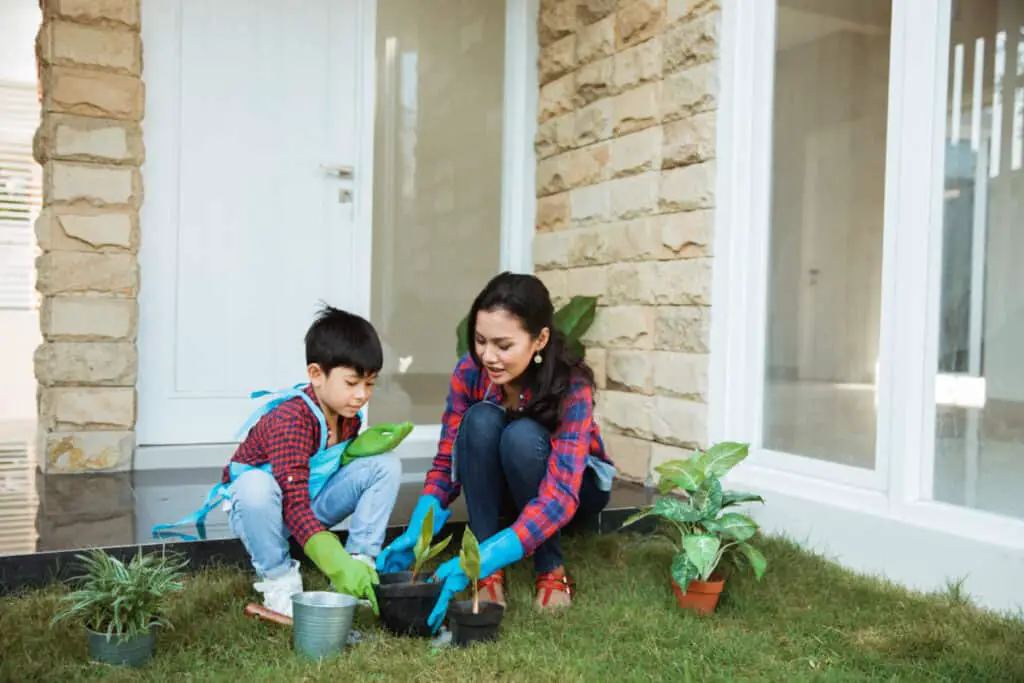Some plants are fussy. Understanding the various ways to grow plants is confusing. There are tons of different plants, safety issues, appropriate living conditions, and materials to consider when planting. Deciding can be challenging, and it’s essential to know the methods and tools you need to succeed with indoor and outdoor planting with children.
Plants are grown indoors or outdoors, depending on the situation. They are grown in planter boxes, gardens, climbing structures, anchored wall baskets, and macrame baskets. Seeds sometimes require germination, and starters are put directly into their living vessel.
Understand the different ways to plant by deciding where the plant will live, whether it is a kid’s or an adult’s project, and purchasing the correct supplies. Make this a family activity if you want to include everyone, and modify the instructions as you see fit. Younger kids will want to manage their plants the way they want. Let them control their project while you do yours.
Planting is a learning experience for the whole family. Communicate through everyone’s steps as they learn more to understand why certain things happened during each unique planting process. There are things that plants need to grow, and appropriate supplies will encourage growth when applied correctly.

What 5 things do plants need to grow?
- Moisture from water
- Adequate sunlight
- Airflow
- Proper nutrients
- An appropriate space with the right soil
What are different ways to grow plants with kids?
There are many different ways to grow plants, depending on your unique indoor or outdoor outside space. Decide how to want to do this project by assessing your area, materials, and the season. Some are better to grow outside, and other plants only grow indoors. Check with your family to see what they prefer trying.
Start by germinating a seed, planting a starter, hanging an indoor plant, or transplanting an established plant from a box into the ground.
Some outdoor areas are more likely to support vertical structures, while others may already have planter boxes or concrete structures. Check your children’s play structures for small bins to plant flowers or herbs around them. Sometimes playsets have rectangular planter boxes screwed onto them or sandboxes built in that are easily refurbished.
Look around to see if there are permanent structures built into your property. Many houses have planter boxes covered with weeds, and people forget to uncover the space to assess its functionality. Sometimes they get turned into sandboxes or toy boxes. Consider replacing them with flowers as your children grow. Throw away old broken toys and explain it is time for a new project for that area.
Semi-permanent tools like metal climbing structures are movable and can be taken to areas that support plant growth. Wood pallets help build raised beds and planter bins. Buckets, concrete tubes, and plastic containers are appropriate for plants that need starting before being transplanted into the ground.
Local pea patches have great ideas for structures too. Go to a local garden to see what structures they use and see if anything you own could turn into something similar. Check out parks that your kids like to play at that might have ideas for incorporating plants into their structures.
Learn about different plant parts to strengthen the learning experience. Kids love to grow plants when they understand the functions and importance of various structures.
How do kids grow plants?
- Start with seedlings or starter
- Find the right place
- Buy or repurpose containers
- Get the right soil
- Continue respositioning for optimal lighting
- Water
- Hardening off to take outside (optional)
Grow a plant by planting the seedlings.
Use a plant starter or a cutting if you want to skip germination. Check the packet, box, or packaging of the plant or seedling to decide on the proper sun exposure.
Clear an area of a table, a porch, or garden to accommodate the new seed. Purchase or repurpose old containers to use for the plant to grow in. Many plants, especially during germination, start inside and move gradually to outside spaces. Some plants are indoor plants that stay indoors. Learn about your specific plant so you can your children decide its appropriate placement.
Purchase appropriate soil for the project. For kid’s projects, you are likely fine with a small amount. When you transplant it outside, consider more soil for the ground.
Once the plant is in the correct container, make sure to position it in an area with appropriate sunlight and a watering container. Kids love to over-water plants which can be okay sometimes because it doesn’t always affect the plant. Indoors use a small vessel, like a plastic cup or a small dropper tool, to help them measure.
At this point, you should know whether your plant wants to remain inside or go outside. If this is your child’s project, ask if they’re going to move it to the porch or shaded outside area when it is germinated and started.
Hardening off is specific, and it’s essential to do it gradually, or it will shock the plant. Decide if that’s okay to try and encourage them to understand the importance of rule-following during this process. Use this as a learning experience if the plant gets shocked and dies.
What materials do you need to grow plant with kids?
Once you have figured out how you want to begin this process –germination vs. cutting– decide what you need by assessing your kid’s age and your space. Egg cartons are familiar for inside germination because they are reusable, compostable, and accessible. Kids have fun with these because they feel personal, so they have their own projects.
The following list is just ideas for you to consider. Please don’t feel pressured to buy all of them. Use some of the terms when searching because they may be helpful, cheap, and easily accessible.
- egg cartons
- petri dishes
- compostable boxes
- glass jars
- planters
- containers
- starting trays
- small cutting, or a seed
- soil
- watering cans
- droppers
What are the stages of seed germination?
A seed includes an embryo and essential nutrients for potential future growth. The exterior, or the seed coat, is a hard shell to protect the plant while inactive. When active, the embryo begins to process or metabolize. This stage is called water imbibition. This happens when the water makes its way past the seed coat to trigger a release of essential enzymes stores within the seed to nourish the seed– resulting in seed growth.
It would be best if you germinated some seedlings inside before they grow. They are typically unable to live and thrive outside if they have not adequately germinated. They remain seeds.
Germination is the process of a seed turning into a sprout. Germination is fun with older kids learning about biology or kids who have the patience to wait. Seed germination at a molecular stage is very cool and pretty complex. There are four basic steps to seed germination.
The four steps of seed germination include water imbibition, nutrient metabolism, the presence of radicles, and plant leaf growth.
- Imbibition: Rapid water imbibition by seed
- Respiration: Reactivation of the metabolic processes within the embryo
- Radicle growth: Radicle, or the first root, protrudes through the seed coat and grows downward into the soil
- Plant leaf development: Cotyledons (first leaves) and stems grow upward and out of the soil.
A seed germinates when the water has made it through the seed coat. Germination is apparent when the shell cracks and the root or radicle appears. It is obvious when there is an appropriate amount of water and warmth; the shell begins to swell to grow the root. Seeds require proper moisture, air (carbon dioxide), energy from the sunlight, and nutrients, usually present in the soil, to grow plants.
Why is it important for children to grow their own plants?
Plants teach kids about plant life
They learn biology
Kids understand responsibility
It helps them stay connected with nature
Reinforces proper eating habits
Promotes sensory experiences
Encourages family bonding
Outside time is relaxing
Introduces procedural tasks
Promotes rule-following
Plants show natural cause-and-effect
Plants are fun
Are indoor plants good for children?
Indoor plants promote airflow and relieve stress and anxiety because they help people connect with nature. Most plants are visually appealing and have a calming effect on children because of their smells, colors, shapes, and textures.
Indoor plants encourage creativity as kids draw and learn to create different patterns and images with art supplies. Plants are living things with unique characteristics and plant personalities. Children gravitate to living things that help them as they find their tiny identities.
Teach them the scientific name because it is fun. They are hard to pronounce, and kids like funny words. Make your own nicknames for the plants by turning the scientific name into a silly name variation.
Visit local nurseries to find more indoor plants appropriate for families and children’s rooms and learn which characteristics they have to decide whether it fits your needs.

What kind of plants do children like to grow?
- succulents
- herbs
- vegetable
- decorative
- flowers
- bushes
Many indoor plants are non-toxic, beautiful to look at, and thick enough for kid’s rooms, outside, and indoor play areas. Children like to grow plants that are pretty, stable, fun, and edible. There are different kinds of plants that have some of these characteristics. Some plants that are stable and decorative will not be edible. Learn the differences between them to understand the subtle differences between plants shapes, colors, smells, and textures.
What kind of plant can I put in my kid’s room?
Many plants are non-toxic and safe for children to grow and even eat. Every person’s area is different. It is hard to know what you have in your area compared to what grows in mine.
I recommend you talk to sales associates at hardware stores when you are purchasing plants. Check the card to see if it says it there, and read it for more information about planting instructions. Check your phone to find a plant identifier application to download like this one.
Lots of plants are appropriate for kids. Here is a list of a few indoor plants that are safe for kids and work well indoors.
- Christmas cactus
- Air plants
- Echeveria
- Lemon trees
- Coleus
- Boston fern
- Spider plant
- African violets
- Miniature roses
- Wandering jew
- Aloe
- Lipstick plant
- Money plant
- Jade plant
What is the easiest way to grow houseplants for kids?
House plants grow quickly in macrame planters near a window, in composable hanging bags, or inside anchored wall planters. Keep them near windows and have the appropriate hardware –hooks or anchors– for security. Consider the placement in children’s rooms to encourage visibility and interest.
It is okay to hang or anchor them near beds and windows, presuming they are non-toxic and won’t bonk anyone’s head. House plants that proliferate and remain sturdy are the best for houses with kids because they are likely to be torn, pulled, and manipulated by tiny human hands.
Stay interested in the process to keep your child engaged and curious. Many skills are learned in a garden, in the home, and through trial and error. Plant success is the process of learning and adapting as you try new things!
